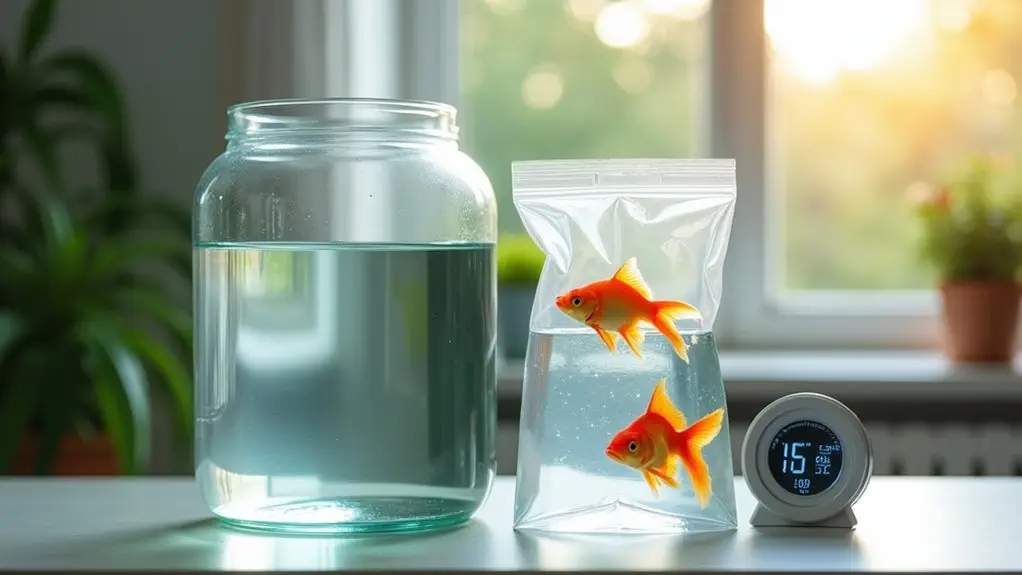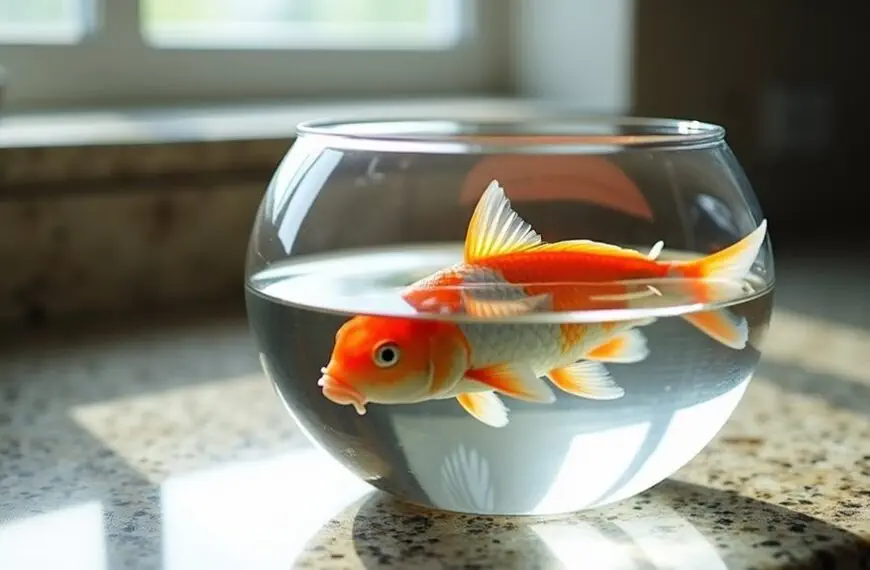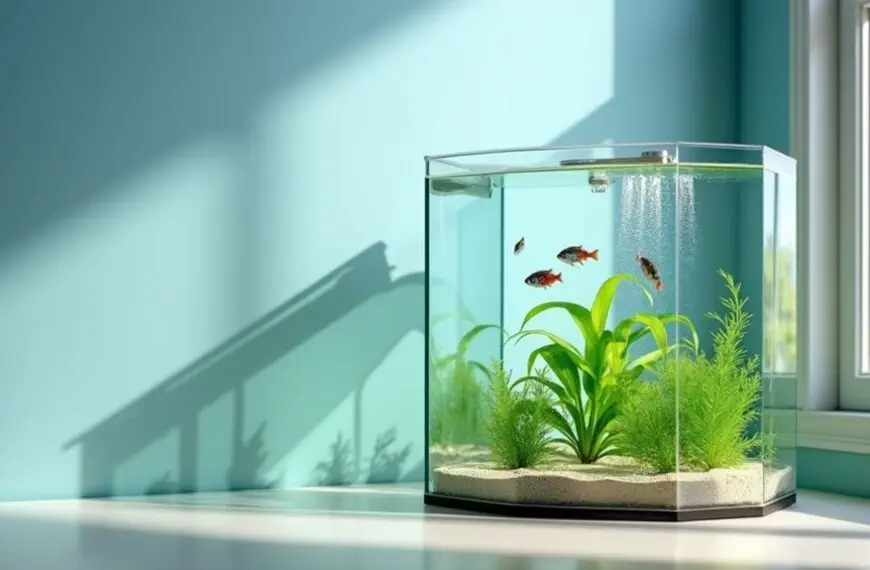You'll need to acclimate your new fish for 30 minutes to 1 hour before adding them to your aquarium. Start by floating their sealed bag in the tank for 15-30 minutes to match water temperatures, or use the drip method for more sensitive species. During this time, your fish will gradually adjust to their new environment's conditions, reducing stress and preventing shock. Keep the lights dimmed and avoid feeding them for at least six hours after introduction. Watch for signs of successful transfer, like active exploration and normal swimming patterns. There's quite a bit more to ensuring your finned friends settle in comfortably.
Contents
- 1 Understanding Proper Acclimation Times
- 2 Temperature Matching Methods
- 3 The Drip Method Process
- 4 Preparing Your Tank First
- 5 Signs of Successful Fish Transfer
- 6 Common Acclimation Mistakes
- 7 Essential Pre-Release Steps
- 8 Post-Release Fish Care Guidelines
- 9 Frequently Asked Questions
- 9.1 Can I Acclimate Multiple Species of Fish at the Same Time?
- 9.2 What Happens if My Power Goes Out During Fish Acclimation?
- 9.3 Should I Keep Filter Media Wet When Transferring Between Tanks?
- 9.4 Can I Use Aged Tap Water Instead of Tank Water?
- 9.5 How Long Should I Quarantine Fish Arriving From Different Stores?
- 10 Final Thoughts
Understanding Proper Acclimation Times
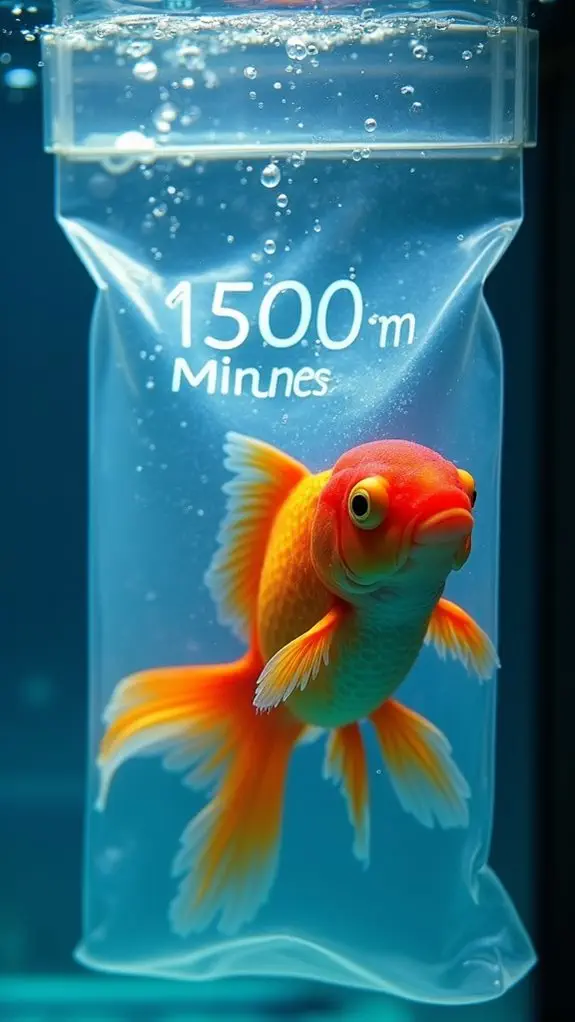
Mastering proper fish acclimation times is essential for your new aquatic pet's survival. When you're excited to introduce your fish to their new home, it's tempting to rush the process, but taking the right amount of time can make all the difference in reducing fish stress and ensuring a smooth adjustment.
The most effective acclimation strategies typically require 30 minutes to an hour of your patience. If you're using the floating bag method, you'll want to give your fish 15-30 minutes to adjust to the tank's temperature. Proper acclimation is critical, as a well-cycled tank establishes beneficial bacteria that can help maintain a stable environment for your new fish. Failing to acclimate properly can lead to shock and potential death of your new fish. Research shows that fish exposed to sudden temperature changes experience reduced aerobic performance, making proper acclimation critical for their health.
Don't leave them floating for too long, though – after 15 minutes in a sealed bag, oxygen levels can drop and cause unnecessary stress to your finned friend.
For more precise control, you might want to try drip acclimation, which can take anywhere from 30 minutes to 2 hours. While it's a bit more involved, it's like giving your fish a gentle introduction to their new environment.
Just remember, whether you choose floating or dripping, you'll want to keep the lights low and watch for any signs that your fish isn't handling the adjustment well.
Temperature Matching Methods
The float method offers you a simple yet effective way to match your new fish's water temperature, working like a gentle handshake between their travel water and your tank.
You'll want to let the sealed bag float for 15-30 minutes, which gives the temperatures time to equalize naturally without stressing your finned friend. This careful calculation also helps ensure that the temperature is consistent with the optimal conditions needed for your fish's health.
When you're using this method, you'll get the added benefit of being able to watch your fish's behavior through the clear bag, helping you spot any potential issues before the actual transfer.
This careful approach helps minimize shock and stress for your new tank inhabitants, ensuring a smoother transition to their new home. A stable pH and hardness in the aquarium water is crucial, so be sure to test water parameters regularly to maintain optimal conditions.
Float Method Benefits
When introducing new fish to your aquarium, float method acclimation stands out as one of the most efficient temperature matching techniques available.
According to experts, the optimal duration for initial temperature acclimation should be 10-15 minutes. This method's advantages include quick temperature adjustment and minimal equipment requirements, making it perfect for both beginners and experienced aquarists. The technique can help prevent fish mortality rates of up to 80% that commonly occur during improper transitions. Furthermore, utilizing the float method before adding your fish contributes to a well-established environment, promoting beneficial bacteria to thrive, which is essential for a healthy tank.
You'll appreciate how the float method helps with fish stress reduction while being incredibly straightforward to implement.
Here are the key benefits you'll experience with the float method:
- Takes only 15-30 minutes for complete temperature matching
- Requires no special equipment beyond your fish bag
- Works effectively for both freshwater and saltwater species
- Allows for easy monitoring of your fish during acclimation
- Provides flexibility to adjust the process based on specific needs
You'll find this method particularly useful when you're working with freshwater fish, though it's adaptable for saltwater species too.
While floating your fish, you can gradually add small amounts of tank water to the bag, helping them adjust to their new environment's parameters. This gradual introduction mimics the cycling process, establishing beneficial nitrifying bacteria which are crucial for maintaining a balanced ecosystem in your aquarium.
Gradual Temperature Equalization
Successfully matching aquarium temperatures requires careful attention to gradual equalization methods that protect your fish from shock.
You'll want to float your fish bag in the tank for 10-15 minutes, though some situations might need up to 30 minutes for proper temperature matching. Think of it as giving your fish a gentle adjustment to their new home – nobody likes jumping into cold water without warning! Transport fish in insulated containers during the move to maintain consistent temperatures. Warm water environments can lead to reduced dissolved oxygen levels, making the acclimatization process even more crucial.
To avoid temperature fluctuations that could cause acclimation stress, you'll need to make adjustments slowly, keeping changes to 1-2°F at a time. Stable temperatures support proper bacterial balance and waste breakdown in your aquarium.
If you notice more than a 5-degree difference between the bag and tank water, you'll definitely want to take extra time with the acclimation process. Place your heater near the water flow to guarantee even heat distribution throughout the tank. Increased temperatures can also elevate fish metabolic rates, which is another reason for careful acclimatization.
You can monitor the progress by checking the temperature every few minutes during acclimation.
It's like being a temperature detective – you're looking for those subtle changes that show you're on the right track.
The Drip Method Process
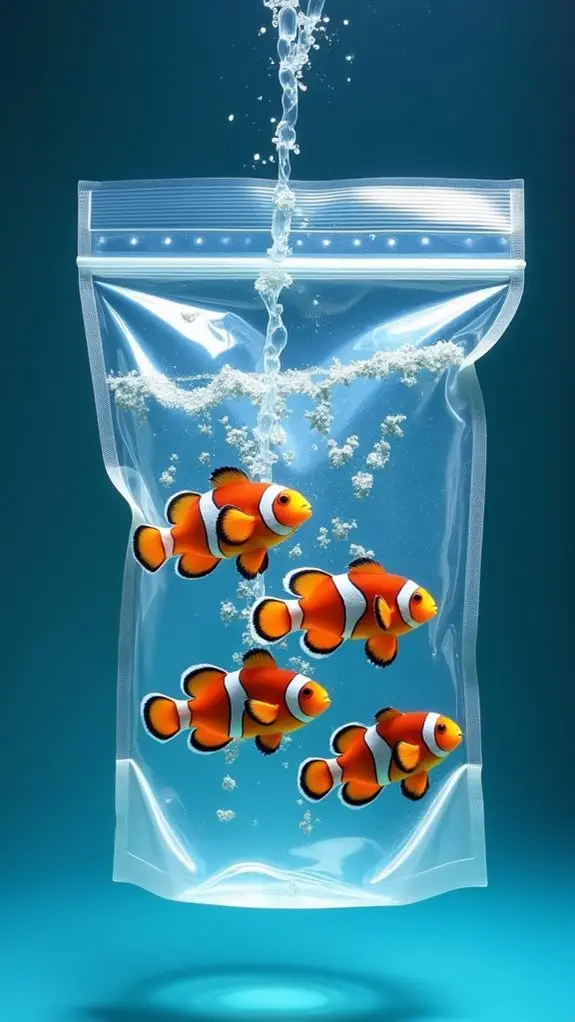
Drip method acclimation stands as one of the most reliable ways to introduce fish to their new aquarium home.
Using an open siphon for faster flow is recommended since the traditional drip method can be too time consuming. Maintaining clean, balanced water is essential for ensuring the health of your fish during the acclimation process.
You'll need to set up a simple system using a bucket, airline tubing, and a few basic supplies to get started. The key to success lies in careful drip rate adjustment and consistent water parameter monitoring throughout the process. This method typically takes 30 minutes to 1 hour depending on your chosen drip rate.
- Place your fish in a bucket with their bag water
- Set up the airline tubing as a siphon from tank to bucket
- Adjust the drip to 2-5 drops per second
- Monitor your fish's behavior for signs of stress
- Check water parameters until they match your tank
Once you've got your setup ready, you'll want to position the bucket right next to your aquarium.
You're aiming to double the water volume in the bucket through the dripping process, which lets your fish gradually adjust to their new water conditions. In addition, monitoring ammonia and nitrite levels during this process is crucial to prevent any spikes in toxicity.
Keep an eye on those parameters – temperature, pH, and salinity are your main concerns here.
When everything matches up perfectly with your tank's conditions, you can finally net your fish and introduce them to their new home.
Preparing Your Tank First
Before you even think about the drip method, proper tank preparation lays the foundation for your fish's survival. Your new aquatic friends need a stable, welcoming environment, and rushing this essential step could lead to some seriously unhappy fish – or worse.
Tank preparation isn't just about filling up with water and calling it a day; it's about creating a thriving underwater world. For proper ecosystem stabilization, you'll need to exercise patience – we're talking 24 to 48 hours minimum, though a week is even better.
During this time, your tank's working behind the scenes to balance temperature, pH levels, and those all-important bacterial colonies. Think of it like preparing a new home: you wouldn't move in before the electricity's working and the plumbing's connected, right?
Don't skip the waiting period, even if your tank looks crystal clear. Your fish will thank you by staying healthy and active instead of suffering from stress or shock.
Focus on getting your lighting, circulation, and water parameters just right. Remember, a well-prepared tank is like a five-star hotel for your fish – and they deserve nothing less! Additionally, this waiting period is crucial for promoting beneficial bacteria growth which is essential for a balanced ecosystem.
Signs of Successful Fish Transfer
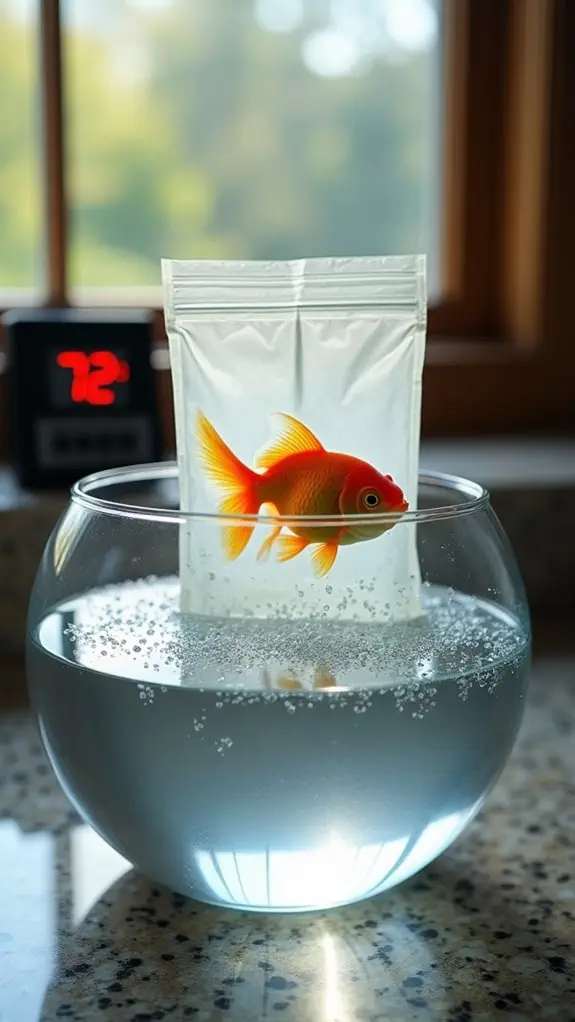
Monitoring your newly transferred fish reveals clear signs of a successful acclimation. You'll want to watch for specific acclimation signs that indicate your aquatic friends are adjusting well to their new home. When fish are comfortable, they'll display natural swimming patterns and won't show signs of stress like rapid breathing or clamped fins.
Here are the key fish behavior indicators you should look for:
- Active exploration of the tank environment
- Normal feeding habits without hesitation
- Friendly interactions with other tank mates
- Stable coloration without sudden changes
- Regular swimming patterns without erratic movements
Keep an eye on your fish's physical appearance too – they should maintain healthy-looking scales and clear eyes. If you notice them playing hide-and-seek behind plants more than usual or refusing their favorite snacks, that might signal they're not quite settled in yet. Additionally, correct water quality management during the acclimation process is crucial for their health and well-being.
Common Acclimation Mistakes
Most fish keepers make vital mistakes during the acclimation process that can harm their aquatic pets. If you're new to keeping fish, you'll want to avoid these common errors that can lead to unnecessary fish stress and potential health issues.
One of the biggest mistakes you'll want to avoid is rushing through your acclimation techniques. Your fish need at least 20-45 minutes to adjust properly, and if you cut this time short, you're putting them at risk of shock. Remember, you can't just dump them into their new home and expect them to thrive!
Another vital error is skipping water parameter tests. You wouldn't want to live in an environment that doesn't suit you, and neither do your fish. Make sure you're checking pH, temperature, ammonia, nitrite, and nitrate levels before introducing your new friends to their tank. Regular monitoring of water quality parameters is crucial for ensuring a healthy environment.
Temperature adjustment is also vital – don't skip the floating bag step! You'll need to monitor the temperature closely and add tank water gradually to the acclimation container. Your fish will thank you for taking the time to help them adjust comfortably to their new environment.
Essential Pre-Release Steps
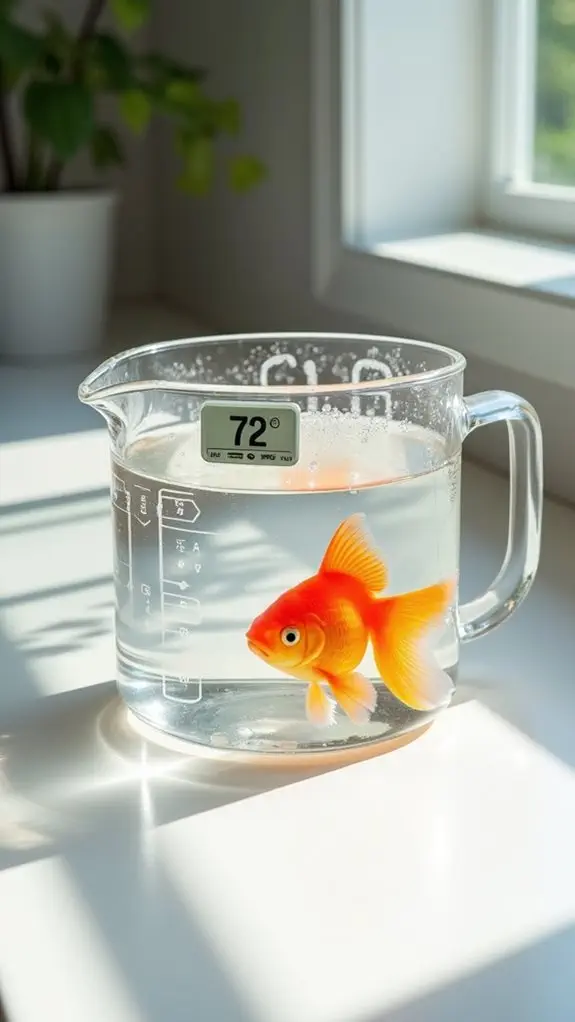
Before you introduce your new aquatic friends to their home, proper tank maintenance and water testing are essential for their survival. You'll want to create an environment that matches their natural habitat as closely as possible.
Here are the key steps you can't afford to skip:
- Research your fish species' specific water parameters (you don't want any fishy surprises!)
- Test and record your current tank conditions, including pH, temperature, and salinity
- Gather all necessary equipment like buckets, nets, and testing kits
- Dim the aquarium lights to reduce stress (fish aren't fans of the spotlight)
- Clean your hands thoroughly to avoid contaminating the water
Additionally, ensure that the tank is fully cycled and filtered to provide a stable home for your new fish before they arrive.
Take your time with these preparations – they're just as important as the acclimation process itself.
Think of it as setting up a five-star hotel for your finned friends! By paying attention to these details, you're creating the best possible welcome for your new fish, and they'll thank you by thriving in their new environment.
Post-Release Fish Care Guidelines
You'll want to keep a close eye on your new fish's behavior throughout their first day in the tank, watching for signs of stress or unusual swimming patterns.
It's best to wait about six hours before offering your fish their first meal, as they'll need time to settle into their new environment.
To guarantee your fish stay healthy during this changeover period, you should track your tank's water parameters daily, paying special attention to ammonia, nitrite, and pH levels. Additionally, ensuring the optimal pH levels in your tank can significantly reduce stress and promote overall fish health.
Monitor First Day Behavior
During the first 24 hours after introducing fish to your tank, careful monitoring becomes essential for their survival and adaptation. You'll want to pay close attention to post release behavior, as these initial hours can make or break fish survival rates.
Watch how your new aquatic friends respond to their environment, and be ready to act if you notice any concerning signs.
- Look for erratic swimming patterns or fish hiding in corners
- Monitor breathing rates – rapid gill movements might signal stress
- Check if they're eating when food is offered
- Watch for aggressive behavior from existing tank mates
- Observe their coloration – pale or darkening colors can indicate stress
Keep your eyes peeled for signs that your fish aren't adjusting well. They might dart around frantically, hide constantly, or show little interest in exploring their new home.
If you notice any concerning behaviors, don't panic – just be prepared to make adjustments. Remember, some fish take longer to acclimate than others, so patience is key.
You'll want to maintain stable water conditions and minimize disturbances during this essential period. Think of it as helping your fish settle into their new apartment – they just need some time to get comfortable!
Feed After Six Hours
Proper feeding timing plays an essential role in helping new fish adjust to their aquarium environment. While you might be tempted to feed your new fish right away, it's best to wait at least six hours after releasing them into the tank. This delay gives them time to settle in and reduces stress during the acclimation process.
When you're ready to establish a feeding schedule, start with a small amount of food to test your fish's appetite. You'll want to observe how they respond to the initial feeding – some fish might enthusiastically swim up for food, while others could be more hesitant.
If your fish seem reluctant to eat, don't worry; it's perfectly normal for them to take up to 24 hours to feel comfortable enough to feed.
Remember to watch for any territorial behavior from existing tank mates that might prevent your new fish from eating. If this happens, you may need to adjust feeding times or locations to guarantee everyone gets their fair share.
You can also try different types of food if your new fish aren't interested in what you're offering.
Track Water Parameters Daily
Monitoring water parameters throughout the first few weeks after introducing new fish stands as one of the most vital aspects of successful acclimation.
You'll need to perform daily testing to guarantee your aquatic friends are thriving in their new home. Think of it as giving your fish a daily health check-up!
Here are the essential parameters you'll want to track every day:
- Ammonia levels (keep them at zero – these little troublemakers can be toxic!)
- Nitrite readings (also aim for zero to keep your fish swimming happily)
- Oxygen content (between 5-10 ppm is the sweet spot)
- Water clarity (crystal clear is what you're after)
- pH stability (avoid those roller-coaster fluctuations)
Parameter stability is your best friend during this vital period.
Keep a logbook of your daily readings – it's like maintaining a fish diary! If you notice any sudden changes, you'll be able to act quickly before small issues become big problems.
Frequently Asked Questions
Can I Acclimate Multiple Species of Fish at the Same Time?
You shouldn't acclimate multiple species together, as each has unique fish compatibility needs. It's best to use separate acclimation techniques for each species to prevent stress and guarantee proper adjustment to tank conditions.
What Happens if My Power Goes Out During Fish Acclimation?
During a power outage, your fish's acclimation process is at risk. You'll need to quickly move them to your tank with existing water. Monitor their behavior closely and keep them calm until power's restored.
Should I Keep Filter Media Wet When Transferring Between Tanks?
Yes, you'll need to keep your filter media wet during tank transfer. It helps preserve beneficial bacteria essential for your aquarium's health. You can drip or spray water to maintain moisture throughout the process.
Can I Use Aged Tap Water Instead of Tank Water?
You shouldn't use aged tap water for acclimation. Even when conditioned, it lacks beneficial bacteria and stable parameters found in tank water. Always use tank water to guarantee your fish's safety during changes.
How Long Should I Quarantine Fish Arriving From Different Stores?
You'll need to quarantine fish for 3-4 weeks from reputable stores, or 4-6 weeks from unverified sources. This quarantine duration helps reduce fish stress and prevents disease spread in your main tank.
Final Thoughts
You've now got all the tools you need to give your new fishy friends the best start in their aquarium home. Remember to take your time with the acclimation process – it's better to spend those extra minutes getting it right than rushing and risking your fish's health. By following proper temperature matching and using the drip method, you'll help guarantee your underwater pals shift smoothly into their new environment. Keep watching them closely, and they'll soon be swimming happily in their new home!

